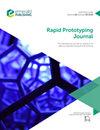在316L不锈钢的SLM工艺中,一种最小化表面粗糙度同时提高材料加工率的新型优化框架
IF 3.6
4区 工程技术
Q1 ENGINEERING, MECHANICAL
引用次数: 0
摘要
316l不锈钢合金由于其通用性和广泛的应用领域(如医疗设备、工具、汽车等),可能是选择性激光熔化(SLM)工艺中使用最多的材料。这就是为什么通过最佳的打印配置来生产功能齐全的部件仍然是一个需要解决的关键问题。本文旨在提出一种全新的框架,在316L不锈钢的SLM工艺中,在降低表面粗糙度(SR)的同时提高材料的加工速度,使基本力学性能保持在允许范围内。设计/方法/方法考虑到整个实验空间中所分析的打印参数与特征之间的非线性关系,定义了机器学习和统计建模方法来描述所选变量在建成条件下的行为。首先,采用Box-Behnken设计,并进行相应的实验规划,测量所需变量。其次,利用经验方法对激光功率、扫描速度、舱口距离、层厚与所选响应之间的关系进行建模。随后,采用非排序遗传算法、多目标粒子群优化算法和交叉熵法三种启发式算法进行比较,搜索公式化多目标问题的Pareto解。结果表明,该材料的最小SR值约为12.83 μm,最大加工速率为2.35 mm3/s。最后,决策系统推荐的一些验证实验强有力地证实了所提出的优化方法的可靠性,提供的最终零件质量和力学性能与文献中定义的几乎相同,最大误差仅约为10%。原创性/价值据作者所知,这是第一个采用完全不同的、更全面的方法来优化316 L SLM工艺的研究,将其嵌入到机械、表面性能和材料加工速度的独特框架中。本文章由计算机程序翻译,如有差异,请以英文原文为准。
A novel optimization framework for minimizing the surface roughness while increasing the material processing rate in the SLM process of 316L stainless steel
Purpose
316 L stainless steel alloy is potentially the most used material in the selective laser melting (SLM) process because of its versatility and broad fields of applications (e.g. medical devices, tooling, automotive, etc.). That is why producing fully functional parts through optimal printing configuration is still a key issue to be addressed. This paper aims to present an entirely new framework for simultaneously reducing surface roughness (SR) while increasing the material processing rate in the SLM process of 316L stainless steel, keeping fundamental mechanical properties within their allowable range.
Design/methodology/approach
Considering the nonlinear relationship between the printing parameters and features analyzed in the entire experimental space, machine learning and statistical modeling methods were defined to describe the behavior of the selected variables in the as-built conditions. First, the Box–Behnken design was adopted and corresponding experimental planning was conducted to measure the required variables. Second, the relationship between the laser power, scanning speed, hatch distance, layer thickness and selected responses was modeled using empirical methods. Subsequently, three heuristic algorithms (nonsorting genetic algorithm, multi-objective particle swarm optimization and cross-entropy method) were used and compared to search for the Pareto solutions of the formulated multi-objective problem.
Findings
A minimum SR value of approximately 12.83 μm and a maximum material processing rate of 2.35 mm3/s were achieved. Finally, some verification experiments recommended by the decision-making system implemented strongly confirmed the reliability of the proposed optimization methodology by providing the ultimate part qualities and their mechanical properties nearly identical to those defined in the literature, with only approximately 10% of error at the maximum.
Originality/value
To the best of the authors’ knowledge, this is the first study dealing with an entirely different and more comprehensive approach for optimizing the 316 L SLM process, embedding it in a unique framework of mechanical and surface properties and material processing rate.
求助全文
通过发布文献求助,成功后即可免费获取论文全文。
去求助
来源期刊

Rapid Prototyping Journal
工程技术-材料科学:综合
CiteScore
8.30
自引率
10.30%
发文量
137
审稿时长
4.6 months
期刊介绍:
Rapid Prototyping Journal concentrates on development in a manufacturing environment but covers applications in other areas, such as medicine and construction. All papers published in this field are scattered over a wide range of international publications, none of which actually specializes in this particular discipline, this journal is a vital resource for anyone involved in additive manufacturing. It draws together important refereed papers on all aspects of AM from distinguished sources all over the world, to give a truly international perspective on this dynamic and exciting area.
-Benchmarking – certification and qualification in AM-
Mass customisation in AM-
Design for AM-
Materials aspects-
Reviews of processes/applications-
CAD and other software aspects-
Enhancement of existing processes-
Integration with design process-
Management implications-
New AM processes-
Novel applications of AM parts-
AM for tooling-
Medical applications-
Reverse engineering in relation to AM-
Additive & Subtractive hybrid manufacturing-
Industrialisation
 求助内容:
求助内容: 应助结果提醒方式:
应助结果提醒方式:


